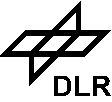
| GSOC Satellite Predictions - Start Page |

|
 The German Space Operations Centre
(GSOC),
which is part of the German Aerospace Centre (DLR), maintains a set of dynamic
Web pages which generate visibility predictions for visible
satellites and Iridium flares for ANY
location on the Earth. The predictions are generated dynamically each time a
page is requested, so you can obtain the very latest predictions, using the most recently available
orbit data, and customised for your own location and time zone. In addition to a summary
page listing all the upcoming visible passes, even more detailed information can be
obtained with a whole page for a particular pass. This detailed
page can then be printed and used as a reference when attempting to observe a satellite. Iridium flares are a recent
phenomena, and are produced by the large fleet of Iridium communications satellites now in low Earth orbit.
These flares only last a few seconds, but can be extremely bright, outshining all the starts and planets
by a large margin.
The German Space Operations Centre
(GSOC),
which is part of the German Aerospace Centre (DLR), maintains a set of dynamic
Web pages which generate visibility predictions for visible
satellites and Iridium flares for ANY
location on the Earth. The predictions are generated dynamically each time a
page is requested, so you can obtain the very latest predictions, using the most recently available
orbit data, and customised for your own location and time zone. In addition to a summary
page listing all the upcoming visible passes, even more detailed information can be
obtained with a whole page for a particular pass. This detailed
page can then be printed and used as a reference when attempting to observe a satellite. Iridium flares are a recent
phenomena, and are produced by the large fleet of Iridium communications satellites now in low Earth orbit.
These flares only last a few seconds, but can be extremely bright, outshining all the starts and planets
by a large margin.
You can either specify your position manually, or, for those people who don't want the bother of finding out what their exact coordinates are, we also provide a large on-line database with the positions and time zones of over 1500 towns and cities throughout the world.
In addition to the predictions, visitors with browsers capable of displaying ActiveX controls can see a real-time, interactive display of the current position of Mir, with their own location also indicated.
Finally, we provide a page which computes the rise and set times of the sun and moon for the user's location.

| To get started, follow one of the two links below to specify your location and time zone, then, when you have reached the GSOC Satellite Predictions home page, add it to your bookmarks and your location and time zone data will be saved for next time. |